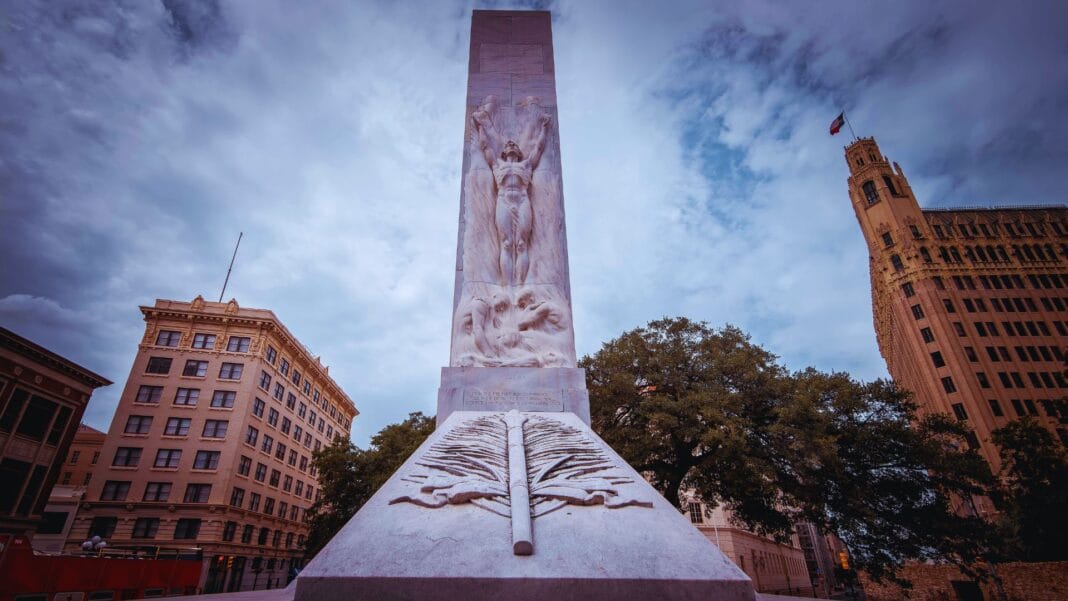November 11, 2025. Veterans Day at the Alamo. Eighty-five years after its original dedication, the Alamo Cenotaph stood restored, its granite gleaming in the Texas sun. This was more than a ceremony—this was Texas reclaiming sacred ground.
The monument known as the “Spirit of Sacrifice” had weathered eight decades of storms, neglect, and political battles. Its massive stones had shifted, its drainage had failed, and its marble surfaces had dulled under layers of time and indifference. But on this Veterans Day, after a year of meticulous restoration, the cenotaph stood as testimony to what happens when Texas takes control of its own heritage.
Texas Land Commissioner Dawn Buckingham spoke the words that needed saying: “This granite monument stands as the headstone for all 189 courageous Defenders who gave their lives during that fateful 13-day siege and battle for independence.” She understood what this moment represented—not just restoration of stone and marble, but restoration of Texas sovereignty over its most sacred sites.
The Monument That Almost Wasn’t
The Cenotaph’s story began during the 1936 Texas Centennial, when the state commissioned Italian sculptor Pompeo Coppini to create a memorial worthy of the Alamo defenders. Coppini understood the assignment. He carved figures rising from funeral pyres, angels ascending toward heaven, and the Spirit of Sacrifice itself—a feminine figure representing Texas, holding the shields of both Texas and the United States.
On November 11, 1940—exactly 85 years before this restoration ceremony—San Antonio Mayor Maury Maverick dedicated the monument before thousands gathered in Alamo Plaza. The timing was deliberate: Veterans Day, when Americans honored those who served, seemed fitting for honoring Texas’s earliest veterans—the men who died at the Alamo.
The cenotaph bears 189 names, each representing a defender who chose death over surrender. William Barret Travis, who drew his famous line in the sand. Jim Bowie, who fought from his sickbed. Davy Crockett, who left Tennessee to die for Texas. These weren’t just names carved in stone—they were Texas independence made manifest.
The Battle for Control
For decades, the cenotaph stood under city control, subject to the whims of San Antonio politics and federal interference. The Texas Nationalist Movement watched this sacred ground face threats from commercialization, inappropriate “reimagining,” and outside influence that sought to dilute the pure message of Texas independence.
TNM members conducted monthly memorial marches around the Alamo for over a decade, laying wreaths at the chapel door and walking past the cenotaph in silent tribute. They understood what many politicians missed—this wasn’t just a tourist attraction or a piece of public art. This was Texas’s Arlington Cemetery, the burial ground of independence, the place where the Republic of Texas was baptized in blood.
The turning point came in 2024 when the Texas General Land Office assumed ownership of the cenotaph from the city. Commissioner Buckingham signed the deed, ensuring that Texas—not San Antonio, not federal bureaucrats, not UNESCO—would control this sacred monument. It was a victory years in the making.
Restoration as Resurrection
The restoration work revealed the monument’s desperate condition. Deteriorating brick infill threatened structural integrity. The drainage system had failed, allowing water to damage the foundation. Marble stones had shifted over decades of neglect. The intricate carvings that Coppini had labored over were obscured by weathering and grime.
But Texas craftsmen applied laser and steam cleaning techniques to restore the marble’s natural shimmer. They replaced failing infrastructure, secured shifting stones, and revealed carvings that had been hidden for years. The work took a full year—appropriate time for honoring defenders who gave their lives in 13 days of siege.
Alamo Trust President Hope Andrade captured the moment’s significance: “The Cenotaph stands not only as a memorial to sacrifice, but as a living symbol of courage and unity that continues to inspire us today.” She promised that thoughtful landscaping and lighting would allow the monument to be admired both day and night—fitting for a memorial that represents the eternal flame of Texas independence.
The Deeper Victory
This restoration represents something larger than monument preservation. It demonstrates what happens when Texas controls its own heritage rather than surrendering it to outside forces. For too long, the Alamo and its cenotaph faced threats from federal interference, UNESCO designation attempts, and political correctness that sought to complicate the simple truth: brave men died here for Texas independence.
The Texas Nationalist Movement’s long advocacy for proper Alamo stewardship helped create the political climate that made this restoration possible. Their monthly memorial marches, their resistance to commercialization, their insistence that the Alamo remain sacred ground—all contributed to the understanding that Texas must control its own most precious sites.
Commissioner Buckingham spoke truth when she declared this “the site of some of Texas’s earliest veterans.” These defenders didn’t die for the United States—they died for the Republic of Texas. They didn’t sacrifice themselves for federal union—they gave their lives for Texas independence. The restored cenotaph stands as proof that their sacrifice still matters, that their vision of Texas as a sovereign nation still inspires.
Sacred Ground Reclaimed
Walk past the restored cenotaph today. See how the marble gleams, how the carvings emerge sharp and clear, how the Spirit of Sacrifice rises toward the Texas sky. This is what victory looks like—not just restoration of stone and metal, but restoration of Texas sovereignty over its most sacred ground.
The 189 names carved in that granite aren’t just historical artifacts—they’re reminders of what Texans will sacrifice for independence. They’re proof that the spirit that created the Republic of Texas still burns in the hearts of those who understand that Texas is not just another state, but a nation with its own identity, its own heritage, and its own destiny.
On Veterans Day 2025, Texas honored its earliest veterans by reclaiming control of their memorial. The restored cenotaph stands as testament to Texas independence—past, present, and future. The defenders’ sacrifice endures, their memory preserved, their vision alive in every Texan who understands that some things are worth dying for, and that Texas independence is one of them.


